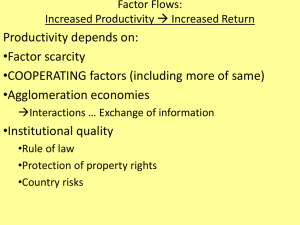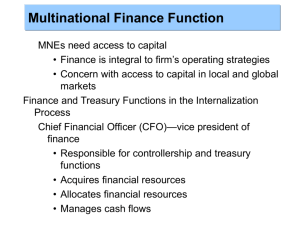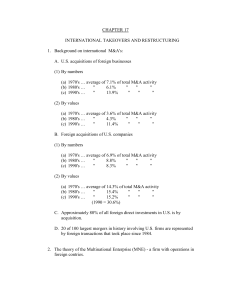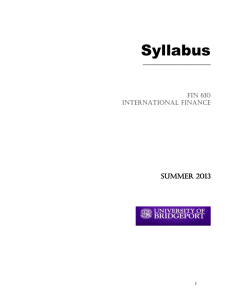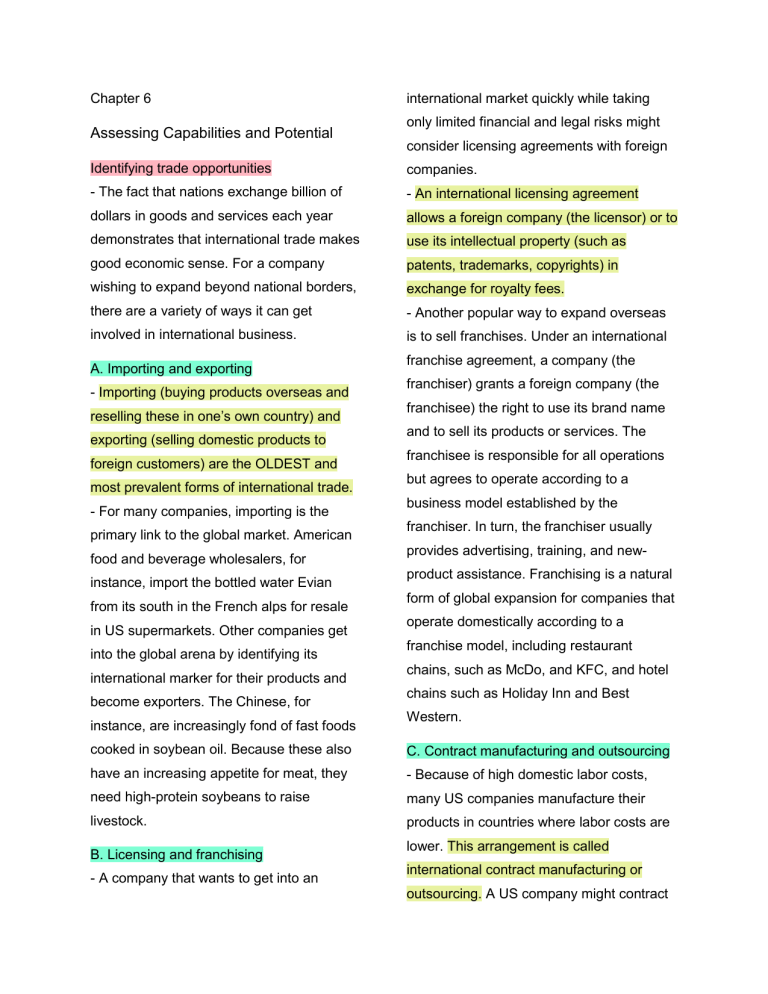
Chapter 6 Assessing Capabilities and Potential international market quickly while taking only limited financial and legal risks might consider licensing agreements with foreign Identifying trade opportunities companies. - The fact that nations exchange billion of - An international licensing agreement dollars in goods and services each year allows a foreign company (the licensor) or to demonstrates that international trade makes use its intellectual property (such as good economic sense. For a company patents, trademarks, copyrights) in wishing to expand beyond national borders, exchange for royalty fees. there are a variety of ways it can get - Another popular way to expand overseas involved in international business. is to sell franchises. Under an international A. Importing and exporting - Importing (buying products overseas and reselling these in one’s own country) and exporting (selling domestic products to foreign customers) are the OLDEST and most prevalent forms of international trade. - For many companies, importing is the primary link to the global market. American food and beverage wholesalers, for instance, import the bottled water Evian from its south in the French alps for resale in US supermarkets. Other companies get into the global arena by identifying its international marker for their products and become exporters. The Chinese, for instance, are increasingly fond of fast foods franchise agreement, a company (the franchiser) grants a foreign company (the franchisee) the right to use its brand name and to sell its products or services. The franchisee is responsible for all operations but agrees to operate according to a business model established by the franchiser. In turn, the franchiser usually provides advertising, training, and newproduct assistance. Franchising is a natural form of global expansion for companies that operate domestically according to a franchise model, including restaurant chains, such as McDo, and KFC, and hotel chains such as Holiday Inn and Best Western. cooked in soybean oil. Because these also C. Contract manufacturing and outsourcing have an increasing appetite for meat, they - Because of high domestic labor costs, need high-protein soybeans to raise many US companies manufacture their livestock. products in countries where labor costs are B. Licensing and franchising - A company that wants to get into an lower. This arrangement is called international contract manufacturing or outsourcing. A US company might contract with a local company in a foreign country to media company) has a strategic alliance manufacture one of its products. It win, with Beijing TV to produce a Chinese- however, retain control of product design language music and entertainment and development and put its own label on programming. the finished product. - Thanks to 21st century information technology non-manufacturing functions can also be outsourced in nations with lower labor costs. US companies increasingly draw on a vast supply of relative inexpensive skilled labor to perform various business services, such as software - An alliance can serve a number of purposes: a. Enhancing marketing efforts b. Building sales and market share c. Improving products d. Reducing production and distribution costs e. Sharing technology development, accounting and claims processing. For years, American insurance - Alliances range in scope from informal companies have processed much of their cooperative agreements to joint ventures – claims-related population with English alliances in which the partners fund a language skills, India has become a center separate entity (perhaps a partnership or a for software development and customer-call corporation) to manage their joint operation. centers for American companies. Magazine publisher Hearst, for ex- has joint ventures with companies in several D. Strategic alliances and joint ventures - What if a company wants to do business in a foreign country but lacks the expertise or resources? Or what if the target nation’s government does not allow foreign companies to operate within its borders unless it has a local partner? In these cases, a firm might enter into a strategic alliance with a local company or even with countries. So, young women in Israel can read Cosmo Israel in Hebrew, and Russian women can pick-up a Russian-language version of Cosmo that meets their needs. The US edition serves as a starting point to which nationally appropriate material is added in each different nation. This approach allows Hearst to sell the magazine in more than 50 countries. the government itself. - A strategic alliance is an agreement E. Foreign direct investments and between two companies (or a company and subsidiaries a nation) to pool resources in order to - As markets expand, a firm might decide to achieve business goals that benefit both enhance its competitive advantage by partners. Ex- Viacom (a leading global making a direct investment in operations conducted in another country. F. Multinational corporations - Foreign direct investment (FDI) refers to - A company that operates in many the formal establishment of business countries is called a multi-national operations on foreign soil – the building of corporation (MNC). Fortune magazine’s factories, sales offices, and distribution roster of the top five hundred MNCs in the networks to serve local markets in a nation world speaks for the growth of non-US other than the company’s home country. On businesses. Only two of the top ten the other hand, offshoring occurs when the multinational companies are headquartered facilities set-up in the foreign country in the US: Wal-Mart (number 1) and Exxon replace US manufacturing facilities and are (number 3). Four others are in the second used to produce goods that will be sent tier (10th through 20th): Chevron, GE, BA back to the US for sale. Shifting production and Conoco- Philips. The remaining 14 are to low wage countries is often criticized as it non-US firms. Interestingly of the 20 top results in the loss of jobs for US workers. companies, 9 are energy suppliers, and 7 - A common form of FDI is the foreign subsidiary: an independent company owned by a foreign firm (called the PARENT). This approach to going international not only gives the parent company full access to local markets but also exempts it from any laws or regulations that may hamper the activities of foreign firms. The parent company has tight control over the operations of a subsidiary, but while senior managers from the parent company often oversee operations, many managers and employees are citizens of the host country. are insurance or financial service firms. - MNCs often adopt the approach encapsulated in the motto “Think globally, act locally”. They often adjust their operations, products, marketing, and distribution to mesh with the environments of the countries in which they operate. Because they understand that a “one-sizefits-all” mentality doesn’t make good business sense when they’re trying to sell products in different markets, they’re willing to accommodate cultural and economic differences. Not surprisingly, most very large firms have foreign subsidiaries. IBM and Coca-cola, for ANALYZING DOMESTIC ex- have both had success in the Japanese CAPABILITIES market through their foreign subsidiaries - Most people think of the production (IBM-Japan, and Coca-Cola-Japan). process as one in which physical goods are produced. However, the process can also be used in generating services, and the two not guarantee that the supplier will get the are quite often interlinked. Sometimes MNE’s business on every bid. However, if goods and/or services are provided directly the supplier is unable to match the cost or by the MNE, other times the MNE has an quality performance of competitive supplies, arrangement with outside firms to suppliers the MNE will eventually terminate the (some of them being direct competitors) to relationship. So there is a great deal of assist in the process. For ex- other firms pressure on the supplier to develop and make some of the Hewlett-Packard printers, maintain state-of-the-art production but HP has its name put on the units and facilities. assumes responsibility for marketing them. - When MNEs turn to global sourcing, there - There is often a mix of product/service is typically a hierarchical order of strategies at work when generating goods consideration. The company gives first and services. The production of goods is preference to internal sources, such as emphasized most heavily because some of having sub-assemblies produced by the the areas under discussion do not lend manufacturing department or the subsidiary themselves to services – although one that that specializes in this work. does is global sourcing, a primary area of consideration in production strategy. B. Production systems - A production system is a group of related A. Global sourcing for raw materials activities designed to create value. In the - Sometimes MNEs produce all the goods generation of goods and services this and services they need. However, they system includes location, layout and often use global sourcing by calling upon material handling. those suppliers who can provide the needed - Location is important because of is impact output more efficiently regardless of where in production and distribution costs. Many they are geographically located. Global MNEs have found that governments sourcing as become important for a number (national and local) are willing to provide tax of reasons. The most obvious one is COST. breaks or other financial incentives to In deciding who will provide these parts and encourage them to set up operations. supplies, the company uses global sourcing - Plant layout is important because of its as do other MNEs. impact on efficiency. For ex- most auto - Not all global sourcing is provided by producers use an assembly line layout in outside suppliers. Some MNEs own their which the workers remain in their station own source of supply or hold an equity and, as the cars move past them, perform position in a supplier. This relationship does the necessary functions such as installing radios, air conditioners, interior trim, and so unloaded at their destination, without any on. repackaging the contents of the container. - Inventory control has received a great deal of attention in recent years because a welldesigned inventory strategy can have b. Cargo vessels - UNCONDITIONAL cargo vessels are used for shipping oversize and unusual cargoes. dramatic effects on the bottom line. One of the most popular concepts has been just-in- c. Roll-on-roll-off (RORO) vessels – are time inventory (JIT for short) which is based ocean-going ferries that can carry trucks on delivering parts and supplies just as they that drive onto built-in ramps and roll of at are needed. No storage of materials the point of debarkation. A carrier similar to because suppliers would be delivering them the RORO is the lighter aboard ship (LASH) just in time for shipment to the factory floor. vessel, which consists of barges that are stored on the ship and lowered at the point C. International logistics - International logistics is the designing and of destination. These individual barges can then operate on inland waterways. managing of a system to control the flow of materials and products throughout the firm. ✓ Air shipping – most countries have This includes the inflow of materials, airports that can accommodate air freight. movement through the production process, The problem with this mode of and outflow to the wholesale/retail firm or transportation is its high cost. Thus, final consumer. although international air freight has grown - In examining international logistics, we dramatically over the last 30 years, it still focus on the primary modes of accounts for less than 1% of the total transportation: ocean and air. The others – volume of international shipments. It is used rails, pipeline and motor carrier – are of in trade more commonly among importance in some regions (such as the industrialized nations than any others, and it European Union). is usually restricted to high value items that ✓ Ocean shipping – international firms can must reach their destinations quickly. choose from a fairly wide variety of ocean D. Packaging carriers. The 3 most common carriers are: - Packaging is important in ensuring that a a. Conventional container ships – are used to carry standardized containers that can be simply loaded onto the carrier and then product is shipped in a safe container and arrives undamaged. When goods are transported a long distance or to areas with climates different from the one where they are manufactured, the container can terminals). prevent spoilage or leakage. Packaging is - Their effective use can help an MNE also important because of its direct effect on cost. If units must be shipped in odd-shaped containers, fewer of them can be loaded into the hold of the transport than if they are shipped in square or rectangular containers and can be loaded atop and alongside each other. - The weight of the packing material is also important, especially when goods are being shipped by air and costs are based on both distance and weight. a. Temporarily store its goods while breaking a large shipment into smaller ones to be shipped to other locales. b. Combine small shipments into larger ones and then reship them c. Process the goods and perform a host of value-added activities before repackaging them for the market d. Give those goods that will remain in the local market a “made in” status so that they can be sold as locally produced products. - Packaging is also important in reducing loading and unloading costs and minimizing theft and pilferage. In recent years many Chapter 7 shippers have begun using intermodal containers, which are large metal boxes that ASSESSING EXPORT INDUSTRIES fit on trucks, railroad trains, and airplanes Small, medium and large business all have and help cut handling costs and theft losses the amazing opportunity to expand by placing the merchandise in an easy-to- internationally, however, there are several move unit that is tightly sealed. steps that must be taken to ensure that a E. Storage company is ready to export. - In some cases, goods that are shipped As the volume of trade grows and barriers internationally have to be stored before to trade fall, competition in a company’s being moved to their final destinations. domestic market intensifies, particularly Some countries have foreign trade zones, from foreign competitors. Competition in our which are areas where foreign goods may own backyard and enter new market for be held and processed and then re- products and services overseas: exported without incurring custom duties 1. Foreign competition is increasing (same as a free trade zone). domestically. To be truly competitive, - These zones are usually found at major companies must consider opening markets ports of entry (including international air abroad. 2. Exporting is profitable. and makes companies stronger in whatever 3. Exporting helps businesses learn how to market they compete. compete more successfully. INDUSTRY STRUCTURE (IN US As global trade grows, companies that DOLLARS) engage in it report a shift in income derived - Integrated circuits and micro-assemblies, from their export sales compared with sales electrical machinery, computer including in their domestic markets. A study of US optical readers, solar power diodes and exporters found that 60% of small semiconductors, electrical converters or companies in the survey derived 20% of power units, printing machinery, insulated annual earnings from exports, while 44% of wire or cable, bananas including plantains, medium-sized companies did. When asked computer parts or accessories then cruise whether export sales would grown at least or cargo ships and barges, were the most 55 per year for the next 3 years, 77% of the valuable exported products in the Phils in small companies and 83% of the medium- 2018. sized companies said they would. - Located in the western Pacific Ocean, the Companies that do not manufacture Southeast Asian nation called the Republic products can profit from exporting by of the Phils shipped US$67.5 Billion worth providing wholesale and distribution of goods around the globe in 2018. That services. dollar amount reflects a -1.8% dip since Why bother to export? 2014 but a 9.2% increase from 2017 to 2018. - Exporting adds to the knowledge and skills - In addition, the Phils furnished an of everyone in a company who does it. estimated $37.5 Billion worth of international Doing business in a market that is beyond services during 2018 encompassing about one’s border can have a transformational $7.5 Billion from travel-related services. effect on its practitioners. - The experience of forming new relationship, getting up close and personal with another culture, figuring out how to meet the needs of others, and learning how to be inventive in addressing new business challenges not only is personally rewarding; it also leads to improvements in products - The focus of this article is on exported goods. - The following export product groups categorized the highest dollar value in Filipino global shipments during 2018. Also shown is the percentage in each export category in terms of overall exports from the Phils. 1. Electric machinery, equipment – US$32.9 EXPORTATION PEFORMANCE (in US Billion (48.7% of total exports) DOLLARS) 2. Machinery including computers – 9.6 - The following types of Filipino product Billion (14.3%) shipments represent positive net exports or 3. Optical, technical, medical apparatus- 2.2 a trade balance surplus. Billion (3.3%) - Investopedia defines NET EXPORTS as 4. Fruits – 2.1 Billion (3.1%) the value of a country’s total exports minus 5. Gems, precious metals – 1.5 Billion the value of its total imports. (balance of (2.2%) payment) 6. Copper – 1.4 Billion (2.1%) 7. Ores, ash – 1.2 Billion (1.8%) 8. Ships – 1.2 Billion (1.8%) 9. Animal, vegetable fats, oils, waxes – 1.2 Billion (1.7%) 10.Mineral, fuels including oil – 1.1 Billion (1.7%) 11.Phils top 10 exports accounted for about four-fifths (80.7% of the overall value of its global shipments) - In a nutshell, net exports represent the amount by which foreign spending on a home country’s goods or services exceeds or lags the home country’s spending on foreign goods or services. 1. Electrical machinery, equipment – US$4.5 Billion (down by 52.4% since 2017) 2. Fruits, nuts – $1.7 Billion (up by 16.7%) 3. Gems, precious metals – 1.2 Billion (down by -0.1%) Fruits and nuts were the fastest-growing 4. Ships, boats - $984.6 Million (down by - among the Phils’ top 10 export categories, 34.1%) up 16% from 2017 to 2018. In second place 5. Copper – 578.2 Million (down by -56.6%) for improving export sales were Filipino 6. Leather/animal gut articles – 423..3 shipments of mineral fuels-related goods Million (up by 14%) which appreciated 10.4% propelled by 7. Meat/seafood preparations – 401.4 better international cashflow from refined Million (down by -16.3%) petroleum oils. Gems and precious metals 8. Knit or crochet clothing, accessories - posted the third-fastest gain up 7%, due $325.9 Million (down by – 23.4%) mainly to support siler sales. Copper was 9. Nickel - $322.1 Million (down by -24.5%) the leading decliner among export 10.Optical, technical, medical apparatus - categories for the Phils due to its -31.7% $230.3 Million (down by -56%) year-over-year drop. - The Phils has highly positive net exports in the international trade of electronic equipment including consumer electronics. - The Phils has highly negative net exports In turn, these cash-flows indicate the Phils and therefore deep international trade strong competitive advantages under the deficits for mineral fuels-related products electronic equipment category. especially refined petroleum oils followed by - However, some aspects of the Phil crude oil, coal then petroleum gas. exportation industry have a negative net export. Overall the Phil incurred a -$47.6 Billion trade deficit in 2018, up 43.6% from $33.2 Billion in red ink one year earlier. - Below are exports from the Phils that result in negative net exports or product trade balance deficits. - These cashflow deficiencies clearly indicate the Phil competitive disadvantages in the international fossil fuel market, but also represent key opportunities for the Phils to improve its position in the global economy through focused innovations particularly in alternative energy sources. - These negative net exports reveal product categories where foreign spending on home country the Phils’ goods trail Filipino Chapter 8 APPRAISING FOREIGN MARKETS importer spending on foreign products. Every multinational has a marketing 1. Mineral fuels including oil - -US$12.7 Billion (up by 22.5% since 2017) 2. Vehicles - -$7.5 Billion (down by -0.9%) 3. Iron, steel - -$5.1 Billion (up by 33%) 4. Machinery including computers - -$3.1 Billion (down by -28.2%) 5. Plastic, plastic articles - -$2.9 Billion (up by 13.8%) 6. Cereals - -$2.7 Billion (up by 50.4%) 7. Aircraft, spacecraft - -$2.3 Billion (up by strategy designed to help identify opportunities and take advantage of them. This plan of action typically involves consideration of four primary areas: a. The product or service to be sold b. The way in which the output will be promoted c. The pricing of the goods or service d. The distribution strategy to be used in getting the output to the customer 77.6%) 8. Pharmaceuticals - -$1.6 Billion (down by - International marketing is the process of 2.2%) identifying the goods and services that 9. Food industry waste, animal fodder - - customers outside the home country want $1.6 Billion (up by 16.1%) and then providing them at the right price 10.Articles of iron or steel - -$1.5 Billion (up and location. by 23.6%) In the international marketplace, this process is similar to that carried out at home, but with some important country that will create new, emerging modifications that can adapt marketing markets. These cursory efforts help an MNE efforts to the needs of the specific country to target potential markets. or geographic locale. For example, some MNEs are able to use the same strategy abroad as they have at home. 2. Second assessment: Financial and economic conditions - Secondary screening is used to reduce the This is particularly true in promotions where list of market prospects by eliminating those messages can carry a universal theme. that fail to meet financial and economic Some writing implement firms advertise considerations. Financial considerations their pen and pencils as “the finest writing include inflation rates, interest rates, instruments in the world,” a message that expected returns on investment, the buying transcends national boundaries and can be habits of customers, and the availability of used anywhere. Many fastfood franchises credit. These factors are important in apply the same ideas because they have determining whether markets that passed found that people everywhere have the the initial, general screening are also same basic reasons for coming there to eat. financially feasible. In most cases, however, a company must - Economic considerations relate to a tailor-make its strategy so that it appeals variety of market demand influences, directly to the local customer. including market indicators. Market INTERNATIONAL MARKET ASSESSMENT indicators are used for measuring the relative market strengths of various 1.Initial assessment: Potential geographic areas, and focus in 3-important - This is the process of determining the areas: basic need and potential of the MNEs goods a. Market size – the relative size of each and services in foreign markets. This market as a percentage of the total world screening answers the question: Who might market. be interested in buying our output? - One way to carry out initial screening is by examining the current import policies of other countries and identifying the goods and services being purchased from abroad. A second way is by determining local b. Market intensity – the “richness” of the market or the degree of purchasing power in one country compared to others. c. Market growth – the annual increase in sales. production. A third is to examine the - Quite often these data are analyzed demographic changes taking place in the through the use of quantitative techniques. Sometimes these approaches are fairly consider. Government stability is an simple. Trend analysis, for ex- is the important factor in starting a successful estimation of future demand either by operation; however, it is often difficult to extrapolating the growth over the last 3 to 5 predict. years and assuming that this trend will 4. Fourth assessment: Sociocultural forces continue or by using some form of average growth rate over the recent past. A similar - The fourth level of screening typically approach is estimation by analogy, through involves the consideration of socio-cultural which forecasters predict market demand or forces such as language, work habits, growth based on information generated in customs, religion and values. As noted other countries. More sophisticated earlier, culture greatly affects the way approach is the use of regression analysis, people live, and MNEs need to examine a mathematical approach to forecasting that how well their operations will fit into each attempt to test the explanatory power of a particular culture. MNEs will examine these set of independent variables. Another sociocultural differences in determining sophisticated approach is cluster analysis, a where to locate operations. marketing approach that involves grouping 5. Fifth assessment: Competitive data on the basis of market area, customer, environment and so on, based on similar variables, so that a marketing strategy can be formulated for each group. - The fifth level of screening is typically focused on competitive forces. If 3 or 4 locations are equally attractive, an MNE will 3. Third assessment: Political and legal often make a final choice based on the aspects degree of competition that exists in each - The third level of screening involves taking locale. In some cases, companies do not a look at political and legal forces. A primary want to enter markets where there is strong consideration is entry barriers in the form of competition. However, they will often decide import restrictions or limits on local to enter a competitive market because they ownership of business operations. Analysis believe the potential benefits far outweigh of these barriers often results in identifying the drawbacks. By going head-to-head with loopholes around the various restrictions or the competition, the company can force data that indicate barriers are far less itself to become more efficient and effective extensive than initially believed. Production and thus improve its own competitiveness. restrictions or limitations on profit remittance The MNE can take market share away form that restrict operating flexibility must also be competitors and put them on the defensive a. Economics – important when the cost of forcing them to commit more resources to a product is either too high or too low to defending the market under attack and make it attractive in another country. thereby reducing their ability to retaliate b. Culture – a product must sometimes be effectively. adapted to different ways of doing things. PRODUCT STRATEGIES Culture also influences purchasing decisions on the basis of style or aesthetics. - It vary depending on the specific good and Other culturally based reasons for product the customers. modifications include color and language. - Some products can be manufactured and c. Local laws – can require product sold successfully both in the US and abroad modification in order to meet environmental by using the same strategies. and safety requirements: Food and - Other products must be modified or pharmaceutical regulations require adapted and sold according to a specially packaging and labeling that are often quite designed strategy. different from those in the home country. 1. Little to no modification Brand-name protection can also require - Industrial goods and technical services are product modification. good examples of product that need little or d. Product life cycle – another reason for no modification. A bulldozer, a laptop and a modifying a product is to cope with its photocopying machine serve the same limited product life cycle (PLC). For ex- purposes and are used the same way in the Coca-Cola of Japan, which introduces an US as they are in France or in China. average of one new soft drink per month - Alterations would be minor and would and has the competition scurrying to keep include such things as adapting the up. Yet, Kola Real has been particularly machine to the appropriate electric voltage effective in offsetting the technology and or changing the language used for its marketing of Coca-Cola to bring its own instructions and labels. The same is true for products to market in Mexico. One of the many types of services. most effective strategies has been to shorten the PLC by offering new goods and 2. Moderate to high modification - A number of factors can compel an MNE to use moderate to high product modification. These include economic, culture, local laws, and product life cycle. services before the demand for the old ones has dropped significantly. Many companies are discovering that by shortening the PLC and offering new product adaptations they are able to capture and retain a large market share. This is typically done by 2. Advertising offering a new product, then modifying it - A non-personal form of promotion in which and bringing out a new version before the a firm attempts to persuade consumers to a competition can effectively combat the first particular point of view. In many cases offering. MNEs use same advertising message PRODUCT PROMOTION worldwide; again, because many products fill similar worldwide needs, a company can - It is the process of stimulating demand for use a universal message and reduce a company’s goods and services. MNEs advertising cots at the same time. However, promote their goods and services through there are times when the advertising must advertising and personal selling. The be adapted to the local market. specific approach used, however, will be - Two of the most common reasons are that: determined by the nature of the product. a. The way in which the product is used 1. Nature of the product differs from that in the home country and, - Identical product and identical message. This approach is used when the MNE intends to sell the same product worldwide b. The advertising message does not make sense if translated directly. and believes that an identical promotional 3. Personal selling appeal can be used in all markets. - It is a direct form of promotion used to - Identical product but different message. persuade customers to a particular point of This strategy is used when the product view. Some goods, such as industrial satisfies a different need in various markets. products or those that require explanation or - Modified product but same message. This description, rely heavily on personal selling. strategy is used when the market requires a - MNEs have also focused attention on different version of the product but the recruiting salespeople on an international needs of the consumer are the same. So basis. In some countries this work is not although the product is changed, the highly regarded, so MNEs have given these promotion message remains the same people managerial titles that command because the buyer’s needs are the same. importance, such as territory manager or - Modified product and modified message. zone manager. Recruiting local talent is When the product use and buying habits of extremely important because these people customers are different from those in the are often better able to sell to local MNEs home market, both the product and customers. If the product requires special promotion message will be modified. training to sell, MNEs often bring new salespeople to the home office for training, introduce them to those who are manufacturing the products, and create a feeling of teamwork among the field staff and personnel so that the salespeople are energized to go back into the field and sell.


